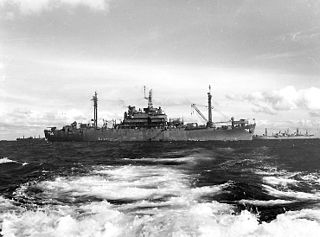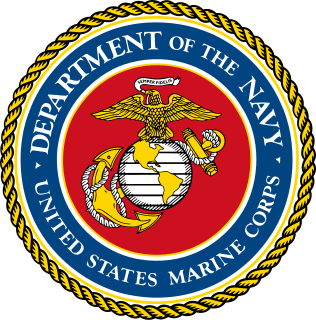
The United States Navy Sea, Air, and Land (SEAL) Teams, commonly known as Navy SEALs, are the U.S. Navy's primary special operations force and a component of the Naval Special Warfare Command. Among the SEALs' main functions are conducting small-unit special operation missions in maritime, jungle, urban, arctic, mountainous, and desert environments. SEALs are typically ordered to capture or to eliminate high level targets, or to gather intelligence behind enemy lines.

The United States Pacific Fleet (USPACFLT) is a theater-level component command of the United States Navy, located in the Pacific Ocean. It provides naval forces to the Indo-Pacific Command. Fleet headquarters is at Naval Station Pearl Harbor, Hawaii, with large secondary facilities at North Island, San Diego Bay on the Mainland.
A task force (TF) is a unit or formation established to work on a single defined task or activity. Originally introduced by the United States Navy, the term has now caught on for general usage and is a standard part of NATO terminology. Many non-military organizations now create "task forces" or task groups for temporary activities that might have once been performed by ad hoc committees.

The United States Fleet Forces Command (USFF) is a service component command of the United States Navy that provides naval forces to a wide variety of U.S. forces. The naval resources may be allocated to Combatant Commanders such as United States Northern Command (USNORTHCOM) under the authority of the Secretary of Defense. Originally formed as United States Atlantic Fleet (USLANTFLT) in 1906, it has been an integral part of the defense of the United States of America since the early 20th century. In 2002, the Fleet comprised over 118,000 Navy and Marine Corps personnel serving on 186 ships and in 1,300 aircraft, with an area of responsibility ranging over most of the Atlantic Ocean from the North Pole to the South Pole, the Caribbean Sea, Gulf of Mexico, and the waters of the Pacific Ocean along the coasts of Central and South America.

The Seventh Fleet is a numbered fleet of the United States Navy. It is headquartered at U.S. Fleet Activities Yokosuka, in Yokosuka, Kanagawa Prefecture, Japan. It is part of the United States Pacific Fleet. At present, it is the largest of the forward-deployed U.S. fleets, with 60 to 70 ships, 300 aircraft and 40,000 Navy, Marine Corps personnel, and Coast Guard support personnel. Its principal responsibilities are to provide joint command in natural disaster or military operations and operational command of all US naval forces in the region.

The Fifth Fleet is a numbered fleet of the United States Navy. It has been responsible for naval forces in the Persian Gulf, Red Sea, Arabian Sea, and parts of the Indian Ocean since 1995 after a 48-year hiatus. It shares a commander and headquarters with U.S. Naval Forces Central Command (NAVCENT) in Bahrain. Fifth Fleet/NAVCENT is a component command of, and reports to, U.S. Central Command (CENTCOM).

The United States Second Fleet is a numbered fleet in the United States Navy responsible for the East Coast and North Atlantic Ocean. The Fleet was established following World War II. In September 2011, Second Fleet was deactivated in view of the United States Government's perception that the potential military threat posed by Russia had diminished. On 4 May 2018, Admiral John M. Richardson, the Chief of Naval Operations, announced plans to reestablish Second Fleet amid heightened tensions between NATO and Russia. It was reestablished on 24 August 2018, with Vice Admiral Andrew "Woody" Lewis in command.

The United States Naval Special Warfare Command (NAVSPECWARCOM), also known as WARCOM is the Naval component of United States Special Operations Command, the unified command responsible for overseeing and conducting the nation's special operations and missions.

Thomas Cassin Kinkaid was an admiral in the United States Navy, known for his service during World War II. He built a reputation as a "fighting admiral" in the aircraft carrier battles of 1942 and commanded the Allied forces in the Aleutian Islands Campaign. He was Commander Allied Naval Forces and the Seventh Fleet under General of the Army Douglas MacArthur in the Southwest Pacific Area, where he conducted numerous amphibious operations, and commanded an Allied fleet during the Battle of Leyte Gulf, the largest naval battle of World War II and the last naval battle between battleships in history.

USS Teton (AGC-14) was a Mount McKinley-class amphibious force command ship in the United States Navy.

The South Pacific Area (SOPAC) was a multinational U.S.-led military command active during World War II. It was a part of the U.S. Pacific Ocean Areas under Admiral Chester Nimitz.

Vice Admiral Daniel Edward Barbey was an officer in the United States Navy who served in World War I and World War II. A graduate of the Naval Academy, he participated in the 1912 United States occupation of Nicaragua and the 1915 United States occupation of Veracruz. While serving with the War Plans Section of the Bureau of Navigation in Washington, D.C. between the World Wars, developed an interest in amphibious warfare. In 1940 he produced Fleet Training Publication 167 – Landing Operations Doctrine, United States Navy, which would become the Navy's "bible" of amphibious operations, and would remain in use throughout World War II.

The United States Fleet Marine Forces (FMF) are combined general- and special-purpose forces within the United States Department of the Navy that perform offensive amphibious or expeditionary warfare and defensive maritime employment. The Fleet Marine Forces provide the National Command Authority (NCA) with a responsive force that can conduct operations in any spectrum of conflict around the globe.
The structure of the United States Navy consists of four main bodies: the Office of the Secretary of the Navy, the Office of the Chief of Naval Operations, the operating forces, and the Shore Establishment.

Expeditionary Strike Group 3 is an expeditionary strike group (ESG) of the U.S. Navy. Expeditionary strike groups combine the capabilities of surface action groups, submarines, and maritime patrol aircraft with those of Amphibious Ready Groups for deployment and maintaining staff proficiencies to provide fleet commanders with a highly flexible, ready fly-away unit. It is capable of projecting expeditionary striking power in the maritime, littoral, and inland environs in support of U.S. national interests.
The United States Eighth Fleet was a numbered fleet of the United States Navy established 15 March 1943 from Northwest African Force. It operated in the Mediterranean Sea during World War II with a main mission of amphibious warfare, and then was active in 1946–47 as the heavy striking arm of the United States Atlantic Fleet. In 1941, the forces that eventually evolved into the Eighth Fleet were designated Amphibious Forces, Atlantic Fleet, under the command of Admiral Henry Kent Hewitt, who took command in April 1942. This force, also called Task Force 34, became the U.S. component of the Operation Torch landings in November 1942. The force was then renamed U.S. Naval Forces, Northwest Africa Waters or COMNAVNAW. On 1 February 1946, U.S. Naval Forces, Northwest African Waters, were redesignated U.S. Naval Forces, Mediterranean, which later became the United States Sixth Fleet.
Task Force 61 (CTF-61) is a task force of the United States Navy that today denotes what used to be designated the Mediterranean Amphibious ready group (MARG) of the United States Sixth Fleet. It is composed of approximately three Amphibious assault ships, but in 2008 is designated the Expeditionary Strike Group that includes their embarked landing craft. From these ships, United States Marine Corps ground forces can move ashore by sea and air in amphibious assault or emergency evacuation missions. Once ashore, the ships of Task Force 61 are able to logistically support the ground forces, until the objective of the landing has been accomplished.
The reconnaissance mission within the United States Marine Corps is divided into two distinct but complementary aspects; Marine Division Recon and Force Reconnaissance.

Expeditionary Strike Group SEVEN/Task Force 76 is a United States Navy task force. It is at one and the same time operationally a task force of the United States Seventh Fleet and administratively, the USN's only permanently forward-deployed expeditionary strike group. It is based at the White Beach Naval Facility at the end of the Katsuren Peninsula in Uruma City, Okinawa, Japan.













